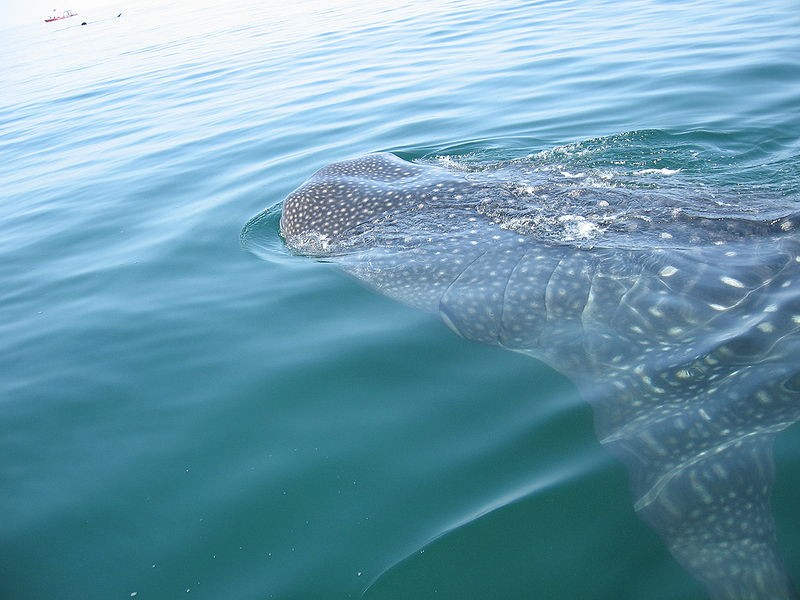Scientists Studying Whale Sharks in Gulf of Mexico

Each June and July near the full moon, the northern Gulf of Mexico hosts a mysterious gathering of whale sharks.
Dozens of the hulking black sharks with white spots glide about with mouths agape as they skim the water’s surface during a 12-hour tuna egg buffet of sorts.
A decade ago, records of these unusual gatherings existed only in fishermen’s tales.
Scientists have spent the past decade piecing together an understanding of the fish’s existence in the northern Gulf and tracking these gatherings that have also been reported in other parts of the world.
“In the past we were amazed just to see 16 animals. … Then look back to 2010, there were 16 to 20 of the animals everywhere you turned,” said Eric Hoffmayer, National Oceanic and Atmospheric Administration research fisheries biologist. “Staying in the water with those guys, it was just a surreal experience.”
Hoffmayer began researching the whale sharks’ habits and habitat in the northern Gulf in 2002. Today the project is a collaborative effort between scientists at the University of Southern Mississippi, NOAA and the Louisiana Department of Wildlife and Fisheries.
The whale shark is the ocean’s largest fish, growing more than 30 feet long and in some cases weighing 20 tons.
LWDF fisheries biologist Jennifer McKinney said these assemblies coincide with tuna spawning events and consistently occur near the Ewing Bank, about 100 miles from Cocodrie.
Researchers are investigating many aspects of the gatherings, including whether they are the result of an “evolutionary memory” or the sharks opportunistically are following spawning fish.
Hoffmayer recalled a research trip to the Ewing Bank in 2010 where on one day they spotted no sharks in the area. The next day, more than 100 converged around them.
“How do you go from zero to 100 animals? It is a 12- to 24-hour event. How are they finding this and where are they coming from?” Hoffmayer said. “We are starting to find out they may be staying with it. It may not be that they move far from it.”
Researchers also are researching whether the shark population in the northern Gulf is resident or migratory.
“We find that it is probably a mixture, We have some that go into the southern Gulf of Mexico. But we have had a few that appear to stay in the northern Gulf during the winter time,” Hoffmayer said.
McKinney said their research includes determining the importance of underwater geographic features and artificial reef structures provided by production platforms in making the northern Gulf a hospitable habitat for the whale shark.
“The overall goal would be to learn more about these animals in our region and determine what connectivity the Gulf has to the rest of the ocean,” Hoffmayer said. “In theory they can go wherever they want. Why is our area important to those guys? That is something in the future we can use to help protect them.”
The sharks are typically observed near the continental shelf edge, around 100 miles out, making them expensive and difficult to observe, McKinney said.
Fly overs, the occasional tagging trip and citizen reports make up most of the data collection currently. In June, researchers encountered about two-dozen whale sharks in the northern Gulf and tagged 10 with trackers, McKinney said.
But those devices only report for six months, giving researchers only a small look at their movements, she said.
Research is also aided by citizen scientists. The University of Southern Mississippi hosts a survey accumulating reports of whale shark sightings. Hoffmayer said more than 600 reports have been received since the program began.
“It is very expensive to go offshore. We do not make that many trips. Everything that we have done is heavily influenced by the public’s data they provide,” Hoffmayer said.
Citizens efforts can be particularly insightful. A unique spot pattern on each whale shark serves as a permanent identifier that is easily photographed, McKinney said.
“That is a natural ‘tag’ that will last for the entire lifespan of the shark. So no matter where that shark goes worldwide that tag will persist. We will be able to see the connection between other areas,” she said.
McKinney said if a boater spots a whale shark, they should try to get a photograph of the animal’s left side. Whale sharks are docile and are most likely feeding if spotted skimming the surface, she said.
Reports of whale shark sightings and photographs can be submitted at www.usm.edu/gcrl/whaleshark or by emailing [email protected].
McKinney said swimming alongside these giants can be life changing, but advised swimmers avoid touching the animal out of concern for the whale’s safety and respect for the fish.
Photo by Miriam Perez



